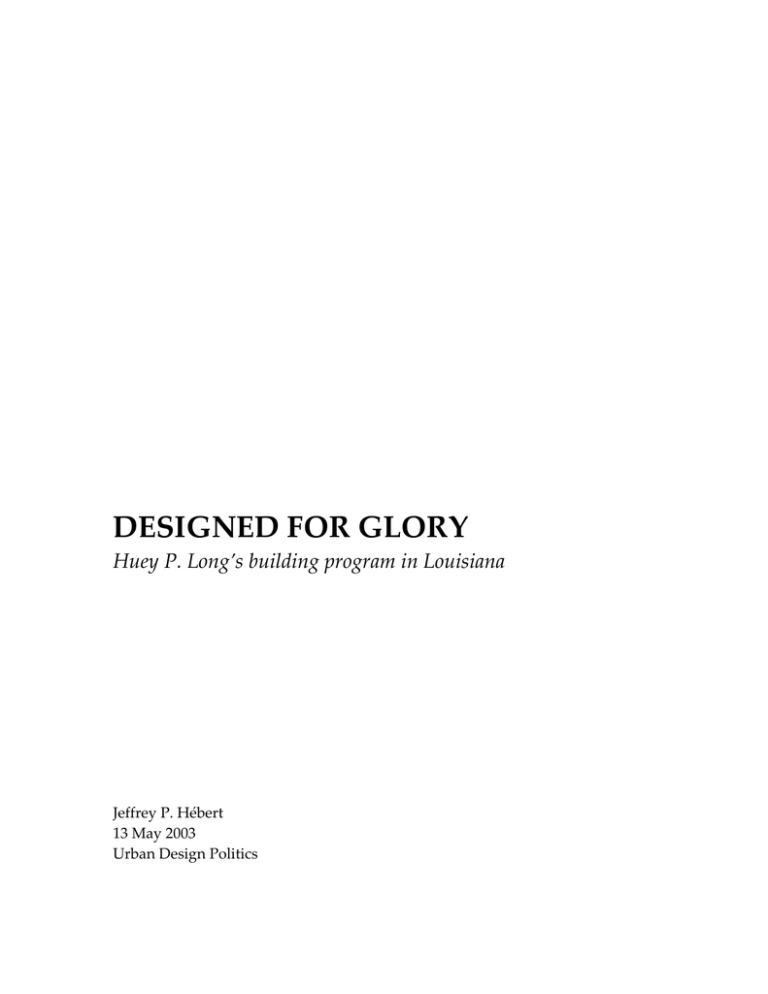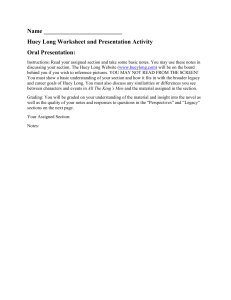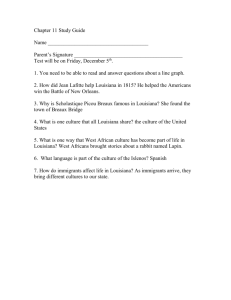DESIGNED FOR GLORY Huey P. Long’s building program in Louisiana
advertisement

DESIGNED FOR GLORY Huey P. Long’s building program in Louisiana Jeffrey P. Hébert 13 May 2003 Urban Design Politics Louisiana is a curious place to most outsiders. It is a state in the union that doesn’t seem to fit the American model. Indeed, the state tourism motto for many years has been, “Come as you are, leave different,” capitalizing on the assumption that most Americans will find the pelican state both unique and intriguing. The food is different, the music is different, the language is different, and the politics are definitely different. As a colony more associated with its Caribbean and Latin American cousins than its contemporary American colonies, Louisiana’s political structure has never followed the American archetype. Explored by the Spanish and settled by the French in the name of le Roi‐ Soleil, Louis XIV, American‐style politics have never suited the Latin heritage and culture of Louisiana where Code Napoleon is the legal guide. In the other 49 states, English Common law is exercised. It is no surprise that among the states of the union, Louisiana is the state known for its colorful politics. “Climactically, racially, to some extent institutionally, Louisiana is closer to Cuba or Mexico than it is to Connecticut. It is semi‐colonial, sharply divided racially, still partly feudal, partly Latin – it jostles constantly with the Latin‐American world. From the beginning there, American democracy has jostled, most unsuccessfully, with class and race rule. American political traditions have never had any rooted vitality in Louisiana.”1 1 Beals, Carleton. The Story of Huey P. Long. London: Lippincott Co. 1935. pp. 14-15. 2 The politics of Louisiana cannot be appreciated under the lens of the American system, they are better understood in relation to nearby Caribbean and Latin American nations. That a Huey Long would become a virtual dictator in Louisiana should not be astonishing. In 1924, a young man from the poor rural Louisiana town of Winnfield decided to run for Governor. There were many obstacles he had to overcome. He grew up in North Louisiana, the Anglo‐Protestant part of the state that had never commanded statewide power. At that time, Louisiana was ruled by the aristocratic plantation owners of South Louisiana. These New Orleanian Catholic Creoles controlled the state and were not willing to relinquish control. It would take a giant to overcome these centuries‐old controls. However, this was no ordinary young man. This was Huey Pierce Long. Huey Long was not by any means typical. He was a man who knew what he wanted and accomplished it by the most unconventional means. He did not graduate from the high school he attended in Shreveport; he found the life of the traveling salesman more interesting. However, while traveling he decided to study law. Somehow, he persuaded the School of Law at Tulane University to admit him despite the fact that he had neither a high school diploma nor any undergraduate credentials. After eight months of study, Huey ran out of money for tuition. Determined not to let this keep him from his goal, the twenty‐one 3 year old appealed to the Louisiana Supreme Court to allow him to take the Bar Exam even though he had not graduated from law school. He was admitted to the bar that same year. Three years later, Huey ran for the position of Railroad Commissioner, one of the most powerful positions in the state. He was elected and served until his election as Governor. Huey Long lost his first gubernatorial election in 1924, but did not let that stop him. He gained more popularity, mainly with the rural poor, and won the subsequent gubernatorial election in 1928. Already outspoken on social and economic issues, Long made a considerable number of enemies. In 1929, he was impeached by the Louisiana House of Representatives and was tried in the Senate unsuccessfully. Born into rural poverty, he had many plans for social welfare improvements. His slogan was “Every man a king.” His dictum was that every home should have electricity, a chicken in the pot, and a car in the driveway. Huey Long had a vision of a modern Louisiana. As Governor, Long went on a building campaign culminating in the building of the new Louisiana Statehouse. Huey Long had every ambition to take complete control of the state when he ascended to the throne of Louisiana. He decided that in order to be most efficient at getting what he desired, he would need to control the various boards of the state. The State Highway Commission, State Board of Health, New Orleans 4 Charity Hospital, Orleans Parish Levee Board, Conservation Department, and the Governing Board of Louisiana State University are just a few of the boards Governor Long seized by a process involving forced resignations and the subsequent appointments of his cronies. “When Huey was criticized for politicizing the Levee Board he piously replied that he hated to do it, but in view of the danger from the river, it was necessary that the Governor and the Board work in harmony.”2 After the gaining control of the state government, he started to work on his ambitious building program that would serve to advance his political agenda. THE STATE CAPITOL “One of Huey P. Long’s dreams was to build a state capitol. The old capitol [ca. 1850], magnificently situated on a bluff overlooking the curving Mississippi, had been designed by the famous architect James Dakin, and ‘testified to a whole generation’s love of chivalry and romance.’”3 The old capitol was seen by Long as too out‐dated and inefficient to serve a modern state government. There had been previous attempts to build a new 2 3 Smith, Webster. The Kingfish: A Biography of Huey Long. New York: Putnam. 1933. p. 48. Jolly, Ellen Roy and James Calhoun. The Louisiana Capitol. Gretna, La.: Pelican. 1980. p.15. 5 state office building, but they were always defeated. Long pushed the idea on grounds that the building would be highly efficient as it would serve as the center for all the offices of state government. He was so determined to build a new statehouse that he exercised many unconventional methods to reinforce the need. “Not above artful shenanigans, Long allegedly had a hole drilled in the roof of the old statehouse above an opponents desk so that water from Baton Rouge’s frequent rains would remind everyone of the need for a new building.”4 Many legislators who opposed Long also opposed the construction bill. As the votes were cast on the construction bill, it looked as though it would not pass. Witnessing this, Governor Long asked the Speaker of the House to halt the voting as he coerced the legislators who hadn’t voted yet to vote in favor of the bill. The construction bill passed the Louisiana State Legislature by 73 votes and appeared on the statewide ballot on November 4, 1930. In a showing of his immense popularity Act 5, House Bill 9 was approved overwhelmingly by the citizens of Louisiana. Interestingly enough, the same time the Capitol Building Act was passed, the citizens overwhelmingly voted Governor Long into the United States Senate. 4 Goodsell, Charles T. The American Statehouse. Lawrence, Kans.: U. of Kansas. 2001. pp.71-72. 6 However, fearing the motives of his Lieutenant Governor5, Long refused to travel to Washington to be sworn in as a United States Senator. For two years, Huey P. Long was both Governor of Louisiana and United States Senator. Long personally selected the New Orleans firm of Weiss, Dreyfous and Seiferth for the capitol project after meeting Leon Weiss at a building dedication ceremony in New Orleans. In a period of two years, the building was designed, planned and erected. Huey Long gave few directives, the building was to be a skyscraper and it was to depict the history of the state. It must be mentioned that the Nebraska State Capitol which was designed a few years earlier by Bertram Grosvenor Goodhue shares the same skyscraper form as the Louisiana Capitol. It is not clear whether or not Long knew this beforehand but the architects must have through architecture publications. In any event, the Louisiana Capitol was to be designed as a monument to the citizens of the state. In fact, it soon became a monument to the power of Huey Pierce Long. The efficiency Governor/Senator Long pushed for in the legislature was lost in the monumentality of the structure. The resulting 34‐storey building, the tallest building in the South for many years and tallest state capitol, is in many ways inefficient. The slender tower is not efficient for state offices as the floors are so small that many state agencies ended up occupying several interrupted 5 On p. 218 of Smith’s biography, Lieutenant Governor Cyr publicly pledged to dismantle the Long regime if he ever got an opportunity. This leads to Long’s paranoia and the eventual state of martial law in Louisiana under his administration. 7 floors of the building. The great Memorial Hall and grand legislative chambers waste a great deal of space because of their monumental scale. There is no efficiency gain in the grand entrance steps that have each of the 50 states engraved in them, nor is there efficiency in the use of expensive marbles for walls, flooring, and sculptures. Statues, friezes, frescoes, bronze work and symbolism can be found throughout the building. Architectonically, the building represents the triumph of the executive over the legislative and judicial branches of government. Its tower overlooks the legislative houses which adjoin the building at the lower level. The State Supreme Court was supposed to occupy the intermediary space where the tower and base overlap. Instead, the court, which despised the governor, decided to remain at their headquarters in New Orleans. Having the state government centralized is, nonetheless, politically efficient. With all agencies centralized, the governor, occupying the center of the government both literally and figuratively, can control the state. To further reinforce the centralizing feature, Long had an electronic voting board installed in his office, concealed by the walnut paneled walls, so he could be up‐to‐the‐minute on the goings on of the legislature. The Louisiana State Capitol was built by the George Fuller Company, famous for their construction of the Flatiron Building in New York City and the Lincoln Memorial in Washington, DC. The building is built in the art deco (beaux 8 arts modernism or art moderne) style. Because it was built during the depression, many gifted artists were given commissions. Among the artists were Lee Lawrie, Lorado Taft, Adolf Weinman, Ulric Ellerhausen and Jules Guerin. The building was constructed on the former campus of Louisiana State University, which had been previously rebuilt by Governors Fuqua and Parker on a 2,000 acre campus south of downtown Baton Rouge. Soon after the construction of the building, Fourth Street in Baton Rouge was widened and realigned to form an allée to the Capitol building and gardens. Although the building is touted as a monument to the people of Louisiana, the building is touted by the people of Louisiana as a monument to their great liberator Huey Long. It is here, in his greatest built achievement, that Long was assassinated. It was in the Great Hall that he laid in state as thousands of people streamed in to say goodbye. It is in the center of the Capitol Gardens where Huey Long lies six feet under. It is doubtful that there is another governmental building in the United States as associated with one politician as this building is. The statue of Long in the Capitol Gardens, which faces the capitol and not Fourth Street, symbolizes the connection between the man and his dream. Architectural historian Henry‐Russell Hitchcock sums up the 9 symbolism of the building best by stating that the capitol “mirrored in its lake and set in a fifty‐acre park, is Huey Long’s monument.”6 THE GOVERNOR’S MANSION “When he was first inaugurated, he had looked over the executive mansion at Baton Rouge. It was an old Southern home which had housed a great many governors, but it didn’t fit in with Huey’s ideas of the pomp and circumstance that should surround him.”7 Having a new capitol wasn’t quite enough to put a new modern face on the state of Louisiana. Huey Long desperately wanted a new Governor’s Mansion. He thought the mansion that had been used since 1858 to be old and cold and too much a reminder of the state’s past. Unfortunately for him, the state legislature thought building a new Governor’s Mansion was gratuitous as the present mansion served the state quite well. Alas, if there would be a new mansion built for a governor, it wouldn’t be built for Huey Long. It has never been clear exactly what happened regarding the Old Governor’s Mansion, but the story that is widely told seems in character with “the Kingfish.” Realizing that the Governor’s Mansion was a necessity and if 6 7 Hitchcock, Henry-Russell. Temples of Democracy. New York: Harcourt Brace Jovanovich. 1976. p.283. Smith, p.53. 10 something were to happen to it, the legislature would have to rebuild it, Huey Long decided to take an unusual path to finance his new mansion. One morning, the governor called a termite inspector (undoubtedly someone on his “payroll”) to inspect the mansion. The termite inspector found the building to be unfit for habitation and the only option was for it to be razed. Governor Long then requested that inmates from the state penitentiary at Angola come to the mansion at Baton Rouge that night and tear it down. The following morning, the governor went to the legislature and requested monies for a new mansion. The Louisiana Governor’s Mansion was built in 1930 by Weiss Dreyfous and Seiferth to a design strikingly similar to that of the White House in Washington, D.C. The building’s model is supposedly Thomas Jefferson’s design for the White House. The mansion’s first floor is identical to the White House, including East Room and West Wing offices. The building is monumental and features many conveniences important to Huey Long. For example, there is an escape stairway in the mansion that allows the governor to slip from the first floor to either the upstairs rooms or the basement garages. The mansion was more of a personal home for Long than it was for the position of governor. In fact, the building is so inextricably linked to Long, when the anti‐Long politicians took over the state under Jimmy Davis in the 1960s, a new mansion was built 11 that evoked Louisiana’s architectural heritage, not the political ambitions of one man. THE LOUISIANA ROADS PROGRAM “In 1928 the late Governor Huey P. Long launched the most comprehensive paving program ever undertaken in the Deep South. Between 1929 and 1936, under what has become known as the Long‐Allen Administration, 9,800 miles of paved and graveled roads were built, involving an expenditure of approximately $140,000,000.”8 Besides upgrading the efficiency of government work, Governor Long had road improvements as one of his top priorities. He imagined that Louisiana could not be a modern state if it did not invest in its antediluvian roads and highways. The cost for such construction would be enormous and it is money that the State Highways Department did not have. Building new highways and roads were a part of his election platform too big to ignore. He could not let this promise fall by the wayside. To pay for the construction of some 9,800 miles of roadway, much of which was causeway construction over the states numerous waterways, the governor introduced a bill in the legislature that doubled the two cents a gallon 8 Works Projects Administration. Louisiana: A Guide to the State. New York: Hastings House. 1941. p.84. 12 tax on gasoline. The bill passed and highway construction soon began.9 However great his highway projects, they are tainted by their political motivations. The gasoline tax and an accompanying sixty‐eight million dollar roads bond issue were passed by the legislature at the same time Governor Long got the impeachment charges brought against him dropped. In many ways, these changes were due to the favorable votes he received on both issues from New Orleans area legislators. He would have to pay them back for their generosity. Out of the highway bonds, New Orleans got the $7,000,000 bridge across the Mississippi River (considered to be the greatest of the road projects), $700,000 per year for paving in the city, and all state highways leading into New Orleans would be repaved.10 LOUISIANA STATE UNIVERSITY “ L.S.U. was a springboard for bold projects for the glory of Huey P. Long. It was a place of academic whoopla, gaudy parades, and Hitleresque ceremonies, where students and professors did not dare tell the truth… The millions spent on L.S.U. were for the 9 Smith, p.51. Ibid. 10 13 purpose of show, political power, and to provide a basis for a nation‐wide conquest of student and professorial support.”11 In many ways, Huey Long’s relationship with the State University was the most troubling of them all. The governor not only had no respect for higher education, he intended to make a spectacle of it. In the years Long governed Louisiana, he censored and controlled L.S.U. in a way only few have attempted. The beginnings of the story of the re‐building of L.S.U. doesn’t begin with Huey Long, as popular myth dictates, instead it starts two administrations before him under the direction of Governors Fuqua and Parker. The present campus had been designed, planned and most of it built years before Long took office as governor. However, as Carleton Beals writes in his biography of Long, “the impression was given that he selected the present university site and erected all its buildings.”12 Governor Long had complete control of the Board of Trustees of the university, and used this power to dismiss and appoint at his discretion. The president of the university was forced to resign as were many deans and professors that opposed his regime. When the recently dismissed president of the university was asked by his faculty about the present condition of the university, 11 12 Beals, pp. 395-396. Ibid. p.385. 14 his answer was,ʺ we’re now living under a dictatorship and the best thing to do is to submit to those in authority.”13 To suggest that Huey Long took credit for the advancement of the university while not doing anything for it is untrue. It is true that he neither selected the site nor the original architects who designed the campus. However, he did have a huge impact on its subsequent expansion. The campus was designed in 1921 by Theodore F. Link in the Mediterranean Mission style as exemplified by the earlier Stanford University campus with landscape design by the Olmsted Brothers under the Fuqua administration. When Huey Long seized power, he immediately started his favorite firm, Weiss, Dreyfous, and Seiferth on his plans for the expansion of the university. The Long administration is responsible for the Stadium/Dormitory complex, Field house, Music and Dramatic Arts Building, and the L.S.U. School of Medicine in New Orleans. The Stadium and Dormitory complex is typical of Huey Long politics. The state legislature disagreed with Long on his expenditures at the university. It must be remembered that this is all happening during the Great Depression. He wanted a new, grand stadium for the football team. The state disagreed and refused to give him money for a football stadium. However, they did agree on appropriating money for the construction of new student dormitories. The 13 Ibid. p.389. 15 governor then met with his architects and together they came up with the idea that both the stadium and dormitories would be built using the same money. The dormitories would be built with the stadium becoming their “roof.” The Huey P. Long Field house is another example of his megalomania and quest for monumentality. Long insisted that he build the student center of the university. The architects came up with the idea of having a field house attached to a student union which was attached to a Roman Bath‐like swimming pool. Not to be outdone by any other university in the country, Long insisted that the pool be the nation’s largest. At the time the building was constructed, the pool measured 181 feet long which is 1 foot longer than the standard. The Medical College of Louisiana, founded in 1834 is the present day Tulane University. The college was founded as a medical school with a teaching hospital. It then became the public University of Louisiana. After a large donation by local philanthropist Paul Tulane, the university became the private Tulane University of Louisiana and retained its medical school in downtown New Orleans. L.S.U., on the other hand, did not have a medical school and many legislators thought the state university should start a medical school and set up a system of teaching hospitals across the state. Always happy with up‐staging Tulane, Huey Long forced the bill’s passage through the legislature and called on 16 Weiss, Dreyfous, and Seiferth to draw up plans for the new medical school and hospital. “…the medical center in New Orleans…a truly worthy achievement, but also partly motivated by his hatred for Tulane University.”14 As a show of his disdain for Tulane, which coincidentally had just competed its own new medical building and hospital, Huey Long built the new L.S.U. Medical Center next door to Tulane Medical Center on Tulane Avenue in downtown New Orleans. What is most disturbing is the architectural scale of the L.S.U. Medical Center. In order to make Tulane appear subservient to L.S.U., Long consolidated Charity Hospital, whose board he controlled, with L.S.U. which then created the second‐largest hospital in the nation, dwarfing the adjacent Tulane center. “But despite the money it cost, despite its elaborate buildings and its gaudy cloak of grandeur, L.S.U. lacked the spirit of a free institution.”15 14 15 Ibid. p.385. Ibid. 17 WHO BENEFITS ? It would seem that although his methods were unconventional, Huey P. Long’s results overshadowed his politics. This may be true. However, in the end, the back‐room deals which were institutionalized under the Long administration were not sustainable and have provided a structure that has ensured skepticism from outside parties with economic development capability. This populist, back‐ room political strategy led to the four time election of governor, now federal inmate Edwin W. Edwards and the slow deterioration of life for many Louisianians. Louisiana officials seemed puzzled when the 2000 census was released that showed a sharp increase in population in the southern states except for Louisiana, which witnessed its citizens out‐migrating to neighboring Texas and nearby Georgia. It’s not the people, it’s the politics. Huey Long’s building projects stand as monuments to him, but because of the legacy of his politics, the citizens have been left with a steep bill that they may never be able to pay in full. It is perhaps too high a price to pay for a historically cash‐strapped state. 18 BIBLIOGRAPHY Beals, Carleton. The Story of Huey P. Long. London: Lippincott. 1935. Goodsell, Charles. The American Statehouse. Lawrence, Kans.: U of Kansas. 2001. Hauck, Eldon. American Capitols. Jefferson, N.C.: McFarland & Co. 1991. Hitchcock, Henry‐Russell. Temples of Democracy. New York: Hacourt Brace Jovanovich. 1976. New Orleans Public Library. “Huey P. Long Photograph Collection.” http://nutrias.org/photos/hueylong/hueyf1.htm Smith, Webster. Kingfish: A Biography of Huey P. Long. New York: Putnam. 1933. “The South’s New Skyscraper Capitol.” The Architectural Forum. Dec. 1932: 520‐ 534. 19 Works Projects Administration. Louisiana: A Guide to the State. New York: Hastings. 1941. 20 MIT OpenCourseWare http://ocw.mit.edu 11.302J / 4.253J Urban Design Politics Spring 2010 For information about citing these materials or our Terms of Use, visit: http://ocw.mit.edu/terms.





